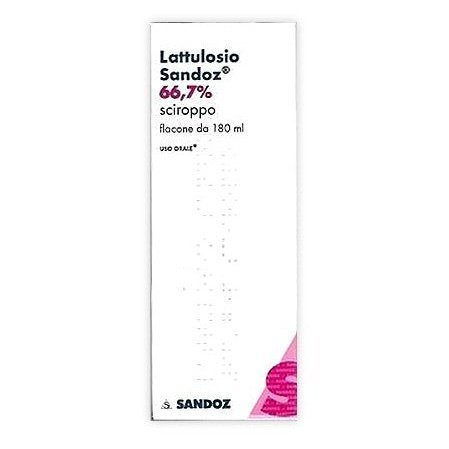
Lactulose Sand Syrup is an osmotic laxative used for the treatment of occasional and chronic constipation. Lactulose works by increasing the water content in the stool, facilitating intestinal transit and promoting natural regularity. It is indicated for adults and children over 2 years old.
Lactulose Sand is indicated for the treatment of occasional or chronic constipation and to soften the stool in conditions requiring facilitated evacuation, such as in the case of hemorrhoids or surgery.
ACTIVE INGREDIENTS
Active ingredients contained in Lactulose Sand Syrup 180 ml - What is the active ingredient of Lactulose Sand Syrup 180 ml?
66.7% syrup, 180 ml bottle: 100 ml syrup contains 66.7 g lactulose. Excipients with known effect: 100 ml syrup contains 0.118 g sodium benzoate. For a full list of excipients, see section 6.1
EXCIPIENTS
Composition of Lactulose Sand Syrup 180 ml - What does Lactulose Sand Syrup 180 ml contain?
Sodium benzoate; purified water.
DIRECTIONS
Therapeutic indications Lactulose Sand Syrup 180 ml - Why is Lactulose Sand Syrup 180 ml used? What is it for?
Short-term treatment of occasional constipation. Adults: occasional constipation; adjuvant in intestinal bacterial infections caused by coliform bacteria (Salmonella, Shigella, etc.). Children and infants: constipation; treatment of putrefactive syndromes due to eating disorders; as a corrective to the infant's diet, especially during the transition from breastfeeding to artificial feeding.
CONTRAINDICATIONS SIDE EFFECTS
Contraindications Lactulose Sand Syrup 180 ml - When should Lactulose Sand Syrup 180 ml not be used?
Hypersensitivity to the active substance or to any of the excipients listed in paragraph 6.1. Laxatives are contraindicated in subjects with acute or unknown abdominal pain, nausea or vomiting, intestinal obstruction or stenosis, rectal bleeding of unknown origin, severe dehydration. Contraindicated in subjects with galactosemia; generally contraindicated in paediatric age (see paragraph 4.4).
DOSAGE
Quantity and method of taking Lactulose Sand Syrup 180 ml - How to take Lactulose Sand Syrup 180 ml?
Dosage; adults: the average daily dosage is 10-15 g in two administrations. This dosage can be doubled or halved depending on the individual response or the clinical picture. Paediatric population; children: from 2.5 to 10 g/day, even in a single administration, depending on the age and severity of the case. Infants: on average 2.5 g per day. The correct dose is the minimum sufficient to produce easy evacuation of soft stools. It is advisable to initially use the minimum doses provided. When necessary, the dose can then be increased, but without ever exceeding the maximum indicated. Preferably take in the evening. Laxatives should be used as infrequently as possible and for no more than seven days. Use for longer periods of time requires a doctor's prescription after adequate evaluation of the individual case. Swallow together with an adequate quantity of water (a large glass). A diet rich in liquids favors the use of the medicine.
CONSERVATION
Storage Lactulose Sand Syrup 180 ml - How to store Lactulose Sand Syrup 180 ml?
This medicinal product does not require any special storage conditions.
WARNINGS
Warnings Lactulose Sand Syrup 180 ml - About Lactulose Sand Syrup 180 ml it is important to know that:
Special warnings: Lactulose is absorbed to a very small extent and has no caloric value. However, Lattulose Sandoz contains, in addition to lactulose, galactose, lactose and small quantities of other sugars. This must be taken into account in the treatment of diabetic patients and patients on low-calorie diets. Abuse of laxatives (frequent or prolonged use or with excessive doses) can cause persistent diarrhoea with consequent loss of water, mineral salts (especially potassium) and other essential nutritional factors. In the most serious cases, dehydration or hypokalaemia may occur, which can lead to cardiac or neuromuscular dysfunction, especially in the case of simultaneous treatment with cardiac glycosides, diuretics or corticosteroids. Abuse of laxatives, especially contact laxatives (stimulant laxatives), can cause dependence (and, therefore, the possible need to gradually increase the dosage), chronic constipation and loss of normal intestinal functions (intestinal atony). Precautions for use: do not use the medicine if you have abdominal pain, nausea and vomiting. If constipation is persistent, consult a doctor. In patients who have problems caused by excessive intestinal meteorism, it is advisable to start treatment with the minimum doses indicated; these doses may be gradually increased in relation to the patient's response. In children under 12 years of age, the medicine can only be used after consulting a doctor. The treatment of chronic or recurrent constipation always requires the intervention of a doctor for diagnosis, prescription of medicines and monitoring during therapy. Consult a doctor when the need for a laxative arises from a sudden change in previous intestinal habits (frequency and characteristics of evacuations) that lasts for more than two weeks or when the use of a laxative fails to produce effects. It is also advisable for elderly subjects or those in poor health to consult a doctor before using the medicine. Important information about some of the excipients: Lactulose Sandoz contains 26.4 mg sodium benzoate per average daily dose equivalent to 0.14 mg/ml. Sodium benzoate may increase jaundice (yellowing of the skin and eyes) in newborns up to 4 weeks of age. Increased bilirubinemia following its separation from albumin may increase neonatal jaundice which may develop into kernicterus (deposits of unconjugated bilirubin in the brain tissue). Lactulose Sandoz contains less than 1 mmol (23 mg) sodium per dose, i.e. essentially 'sodium-free'.
INTERACTIONS
Interactions Lactulose Sand Syrup 180 ml - Which medicines or foods can modify the effect of Lactulose Sand Syrup 180 ml?'
Broad-spectrum antibacterial agents, administered orally at the same time as lactulose, may reduce degradation, limiting the possibility of acidification of the intestinal contents and consequently the therapeutic efficacy. Laxatives may reduce the residence time in the intestine, and therefore the absorption, of other medicinal products administered orally at the same time. Therefore, avoid taking laxatives and other medicinal products at the same time: after taking a medicinal product, leave an interval of at least 2 hours before taking the laxative.
SIDE EFFECTS
Like all medicines, Lactulose Sand Syrup 180 ml can cause side effects - What are the side effects of Lactulose Sand Syrup 180 ml?
Gastrointestinal disorders, occasionally: isolated cramping pain or abdominal colic, more frequent in cases of severe constipation. Frequency not known: flatulence. Immune system disorders. Frequency not known: hypersensitivity reactions. Skin and subcutaneous tissue disorders. Frequency not known: rash, pruritus, urticaria. Reporting of suspected adverse reactions. Reporting suspected adverse reactions that occur after authorisation of the medicinal product is important, as it allows continued monitoring of the benefit/risk balance of the medicinal product. Healthcare professionals are asked to report any suspected adverse reactions via the national reporting system at https://www.aifa.gov.it/content/segnalazioni-reazioni-avverse.
PREGNANCY AND BREASTFEEDING
If you are pregnant or breast-feeding, think you may be pregnant or are planning to have a baby, ask your doctor for advice before taking Lactulose Sand Syrup 180 ml
There are no adequate and well-controlled studies on the use of the medicinal product during pregnancy or breastfeeding. Therefore, the medicinal product should be used only when necessary, under the direct supervision of a doctor, after evaluating the expected benefit for the mother in relation to the possible risk for the fetus or infant.

























